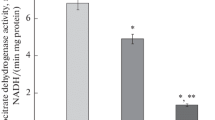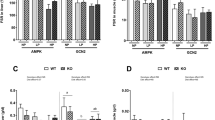Abstract
The content of liver cytosolic proteins was studied in mice subjected to protein depletion followed by refeeding with a normal diet. Depletion elicited either the accumulation or the decrease of several polypeptides, being the early increase of a Mr 36 000 polypeptide the most pronounced change observed. The refeeding with a normal diet for 2 days caused a return of the cytosol protein composition to that of normally fed animals. The Mr 36 000 polypeptide was identified as glyceraldehyde-3-phosphate dehydrogenase (GAPDH). Its molecular weight, the sequence of its first twenty amino acid residues, its amino acid composition and its antigenic properties were found to be similar with those of GAPDH from different mammalian cells. During the first 2 days of protein depletion, both the GAPDH polypeptide content and activity increased. Thereafter, the enzymatic activity of GAPDH decreased, whereas GAPDH protein mass decreased in a lesser extent. The accumulation of GAPDH and other particular polypeptides in the cytosols of protein depleted mice was associated with an increased synthesis. The refeeding with a normal diet caused an immediate return to the synthesis pattern of normal livers.
Similar content being viewed by others
References
Dice JF: Molecular determinants of protein half-lives in eukaryotic cells. FASEB J 1: 349–357, 1987
Garlick PJ, Waterlow JC, Swick RW: Measurement of protein turnover in rat liver. Analysis of the complex curve for decay of label in a mixture of proteins. Biochem J 156: 657–663, 1976
Scornik OA, Botbol V: Role of changes in protein degradation in the growth of regenerating liver. J Biol Chem 251: 2891–2897, 1976
Conde RD, Scornik OA: Role of protein degradation in the growth of livers after a nutritional shift. Biochem J 158: 385–390, 1976
Conde RD, Scornik OA: Faster synthesis and slower degradation of liver proteins during developmental growth. Biochem J 166: 115–121, 1977
Augustine SL, Swick RW: Turnover of total proteins and ornithine aminotransferase during liver regeneration in rats. Am J Physiol 238: E46-E52, 1980
Bur JA, Conde RD: Decreased rate of protein breakdown during nutritional recovery of mouse kidney. Am J Physiol 243: E360-E364, 1982
The Pharmacopeia of the USA; Protein-Biological adequancy test. Depletion diet. Vol. XV: 882–883, 1955
Laemmli UK: Cleavage of structural proteins during the assembly of the head of bacteriophage T4. Nature (London) 227: 680–685, 1970
Laskey AR, Mills AD: Quantitative film detection of H and C in polyacrylamide gels by fluorography. Eur J Biochem 56: 335–341, 1975
Lowry OH, Rosebrough NJ, Farr AL, Randall RJ: Protein measurement with the folin phenol reagent. J Biol Chem 193: 265–275, 1951
Matsudaira P: Sequence from picomole quantities of protein electroblotted onto polyvinylidene difluoride membranes. J Biol Chem 262: 10035–10038, 1987
Kulbe KD, Bojanovski M: 3-Phosphoglycerate kinase from bovine liver and yeast. Methods EnzymoL 90: 115–120, 1982
Hawkes R: The dot immunobinding assay. Methods Enzymol 121:484–491, 1986
Ey PL, Ashman LK: The use of alkaline phosphatase-conjugated anti-immunoglobulin with immunoblots for determining the specificity of monoclonal antibodies to protein mixtures. Methods Enzymol 121: 497–509, 1986
Penny IF, Taylor MAJ, Harris AG, Etherington DJ: Purification and immunological characterisation of two calcium-activated neutral proteinases from rabbit skeletal muscle. Biochim Biophys Acta 829: 244–252, 1985
Tso JY, Sun XH, Kao TH, Reece KS, Wu R: Isolation and characterization of rat and human glyceraldehyde-3-phosphate dehydrogenase cDNAs: genomic complexity and molecular evolution of the gene. Nucleic Acids Res 13: 2485–2502, 1985
Harris JI, Waters M: Glyceraldehyde-3-Phosphate Dehydrogenase. Enzymes 3rd Ed. 13: 1–49, 1976
Fort P, Marty L, Piechaczy M, El Sabrouty S, Dani C, Jeanteur P, Blanchard JM: Various rat adult tissues express only one major mRNA species from glyceraldehyde-3-phosphate dehydrogenase multigenic family. Nucleic Acids Res 13: 1431–1442, 1985
Metzger H, Shapiro MB, Mosimann JE, Vinton JE: Assessment of compositional relatedness between proteins. Nature 219: 1166–1168, 1968
Lipman DJ, Pearson WR: Rapid and sensitive protein similarity searches (through National Biomedical Research Foundation Protein Sequence Database). Science 277: 1435–1441, 1985
Pucciarelli MG, Conde RD: Breakdown of proteins from mouse liver subcellular fractions. Effect of nutritional changes. Acta Physiol Pharmacol Latinoam. 34: 185–191, 1984
Spiegelman BM, Green H: Control of specific protein biosynthesis during the adipose conversion of 3T3 cells. J Biol Chem 255: 8811–8818, 1980
Alexander M, Curtis G, Avruch J, Goodman HM: Insulin regulation of protein biosynthesis in differentiated 3T3 adipocytes. J Biol Chem 260: 11978–11985, 1985
Alexander M, Lomanto M, Nasrin N, Ramaika C: Insulin stimulates glyceraldehyde-3-phosphate dehydrogenase gene expression through cis-actin DNA sequences. Proc Natl Acad Sci USA 85: 5092–5096, 1988
Rivett AJ, Hare JF: Enhanced degradation of oxidized glutamine synthetase in vitro and after microinjection into hepatoma cells. Arch Biochem Biophys 259: 423–430, 1987
Rivett AJ: Regulation of intracellular protein turnover: covalent modification as a mechanism of marking proteins for degradation. Curr Top Cell ReguL 28: 291–337, 1986
Brodie AE, Reed DJ: Reversible oxidation of glyceraldehyde-3-phosphate dehydrogenase thiols in human lung carcinoma cells by hydrogen peroxide. Biochim Biophys Res Commun 148: 120–125, 1987
Katunuma N, Kominami E: Lysosomal sequestration of cytosolic enzymes and lysosomal thiol cathepsins. Adv Enz Reg 23: 159–168, 1985
Johnson LW, Velick SF: The synthesis and degradation of fructose diphosphate aldolase and glyceraldehyde-3-phosphate dehydrogenase in rabbit liver. J Biol Chem 247: 4138–4143, 1972
Hanauer A, Mandel JL: The glyceraldehyde 3 phosphate dehydrogenase gene family: structure of a human cDNA and of an X chromosome linked pseudogene; amazing complexity of the gene family in mouse. EMBO J 3 (11): 2627–2633, 1984
Piechaczyc M, Blanchard JM, Riaad-El Sabouty S, Dani C, Marty L, Jeanteur P: Unusual abundance of vertebrate 3-phosphate dehydrogenase pseudogenes. Nature 312: 469–471, 1984
Dugail I, Quignard-Boulange A, Bazin R, Le Liepvre X, Lavau M: Adipose-tissue-specific increase in glyceraldehyde-3-phosphate dehydrogenase activity and mRNA amounts in suckling pre-obese Zucker rats. Biochem J 254: 483–487, 1988
Fallon HJ, Hackney EJ, Byrne WL: Serine biosynthesis in rat liver. J Biol Chem 241: 4157–4167, 1966
Bannash P, Hacker HJ, Khmer F, Mayer D: Hepatocellular glycogenosis and related pattern of enzymatic changes during hepatocarcinogenesis. Adv Enz Reg 22: 97–121, 1984
Bannash P, Hacker HJ, Tsuda H, Zerban H: Aberrant regulation of carbohydrate metabolism and metamorphosis during renal carcinogenesis. Adv Enz Reg 25: 279–296, 1986
Farwell DC, Miguez JB, Herbst EJ: Ornithine decarboxylase and polyamines in liver and kidneys of rats on cyclical regimen of protein-free and protein-containing diets. Biochem J 168: 49–56, 1977
Author information
Authors and Affiliations
Rights and permissions
About this article
Cite this article
Sanllorenti, P.M., Tardivo, D.B. & Conde, R.D. Dietary level of protein regulates glyceraldehyde-3-phosphate dehydrogenase content and synthesis rate in mouse liver cytosol. Mol Cell Biochem 115, 117–128 (1992). https://doi.org/10.1007/BF00230321
Received:
Accepted:
Issue Date:
DOI: https://doi.org/10.1007/BF00230321




